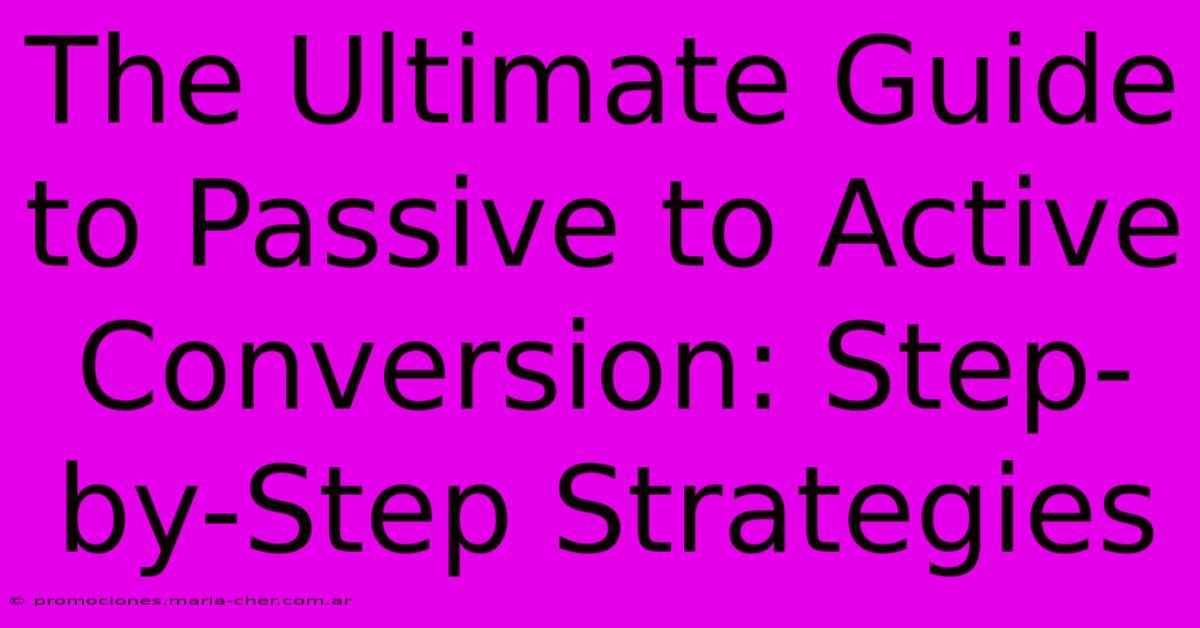The Ultimate Guide To Passive To Active Conversion: Step-by-Step Strategies

Table of Contents
The Ultimate Guide to Passive to Active Conversion: Step-by-Step Strategies
Passive voice, while sometimes necessary, can often make your writing sound weak, indirect, and less engaging. Active voice, on the other hand, is more direct, concise, and powerful. This ultimate guide provides a step-by-step approach to converting passive sentences into their active counterparts, significantly improving the clarity and impact of your writing.
Understanding the Difference: Passive vs. Active Voice
Before diving into the conversion strategies, let's clarify the core distinction:
-
Passive Voice: The subject receives the action. The verb often includes a form of "to be" (is, are, was, were, been, being) followed by a past participle. Example: The ball was thrown by the boy.
-
Active Voice: The subject performs the action. The verb directly connects the subject to the action. Example: The boy threw the ball.
Notice how the active voice version is more concise and impactful. It immediately tells us who did what.
Step-by-Step Strategies for Passive to Active Conversion
Here's a practical, step-by-step guide to transform your passive sentences into dynamic active ones:
Step 1: Identify the Passive Sentence
The first step is recognizing passive constructions. Look for sentences containing a form of "to be" followed by a past participle. Sometimes, the passive voice is disguised with phrases like "it is believed that," "it was reported that," or similar constructions.
Step 2: Find the Actor (Subject)
In passive sentences, the actor (the one performing the action) is often hidden or placed at the end of the sentence using a "by" phrase. Identify this actor. If the actor is unknown or unimportant, you can sometimes omit it in the active version.
Step 3: Determine the Action (Verb)
Find the verb in the passive sentence. This is usually the past participle following the "to be" verb.
Step 4: Reframe the Sentence in Active Voice
Now, reconstruct the sentence, placing the actor as the subject and the verb directly connected to the subject. Consider these examples:
-
Passive: The report was written by the committee.
-
Active: The committee wrote the report.
-
Passive: Mistakes were made.
-
Active: Someone made mistakes. (The actor is unknown, so we use "someone")
-
Passive: The building is being renovated.
-
Active: Workers are renovating the building. (We added a more specific subject)
Step 5: Refine and Edit
After converting, review your sentence for clarity and conciseness. Sometimes, minor adjustments in wording will further improve the flow and impact.
Advanced Techniques for Complex Passive Sentences
Some passive sentences can be more challenging to convert. Here are some advanced techniques:
-
Dealing with "It" and "There": Sentences starting with "It is" or "There are" often signal passive voice. Analyze the meaning to identify the true subject and action.
-
Handling Multiple Clauses: Break down complex sentences into smaller, simpler sentences before converting to active voice.
-
Passive Voice Exceptions: While generally preferring active voice, remember that some instances genuinely benefit from passive voice – for example, when the actor is unknown or unimportant, or when emphasizing the action itself rather than the actor.
Benefits of Using Active Voice
Switching to active voice yields significant improvements in your writing:
-
Improved Clarity: Active voice makes your meaning instantly clear, reducing ambiguity.
-
Enhanced Conciseness: Active voice sentences are typically shorter and more direct.
-
Increased Engagement: Active voice creates a more dynamic and engaging reading experience for your audience.
-
Stronger Impact: Active voice delivers a more forceful and confident tone.
By mastering the techniques outlined in this guide, you can transform your writing from passive and unclear to active and impactful. Consistent use of active voice will significantly elevate the quality and readability of your work, leading to more effective communication.

Thank you for visiting our website wich cover about The Ultimate Guide To Passive To Active Conversion: Step-by-Step Strategies. We hope the information provided has been useful to you. Feel free to contact us if you have any questions or need further assistance. See you next time and dont miss to bookmark.
Featured Posts
-
Revolutionize Classrooms With Digital Streaming A Guide For Ed Pros
Feb 07, 2025
-
Science Behind The Rainbow Exploring The Genetics Of Baguette Colors
Feb 07, 2025
-
Investment Vs Indulgence Decoding The Value Proposition Of Vermeil And Gold Plated
Feb 07, 2025
-
Unlock The Secrets Of Streaming Apps The Ultimate Guide For Educators
Feb 07, 2025
-
Monochrome Magic Discover The Perfect Black And White Portrait Backgrounds
Feb 07, 2025
